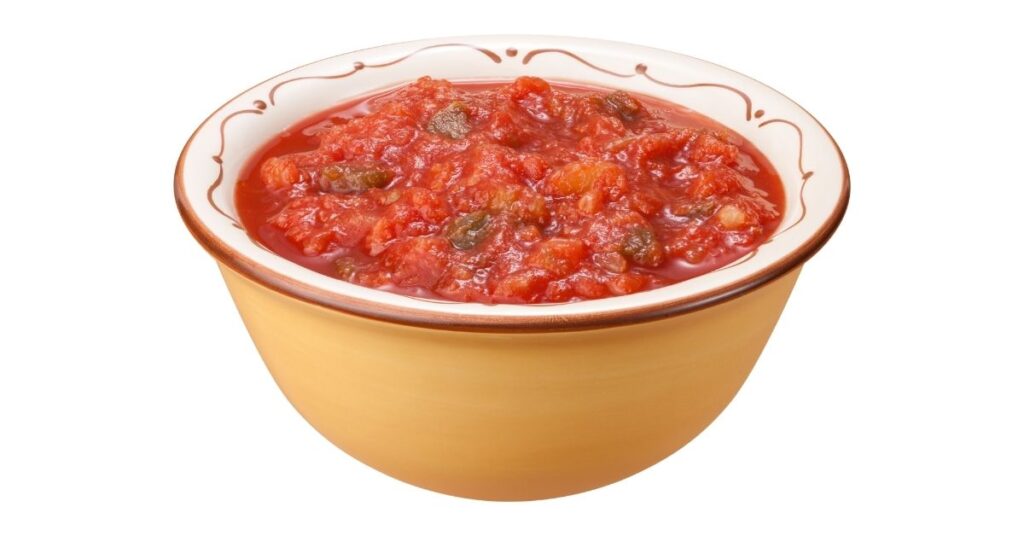Opened store-bought salsa lasts 1-2 weeks in the fridge; homemade salsa is good for 5-7 days.
How Long Is Salsa Good
The lifespan of salsa depends on several factors, including whether it’s store-bought or homemade, what ingredients it contains, and how it’s stored. Generally, an opened jar of store-bought salsa will stay fresh in the refrigerator for about 1-2 weeks, while homemade salsa typically lasts 5-7 days.
Why Does Salsa Go Bad?
Salsa spoils due to several factors – here are the biggest culprits:
- Microbial Growth: Bacteria, yeast, and mold are the primary culprits in salsa spoilage. These microorganisms thrive in moist, slightly acidic environments like salsa.
- Oxidation: Exposure to air causes oxidation, leading to changes in salsa’s color, flavor, and texture.
- Enzymatic Activity: Even in the refrigerator, enzymes within the salsa ingredients continue to break down, affecting taste and texture.
Signs Your Salsa Has Gone Bad
Don’t risk a bad case of food poisoning! Here are telltale signs your salsa is past its prime:
- Mold: Any visible mold growth, no matter how small, is a clear sign to toss the salsa.
- Off Odors: If your salsa smells sour, fermented, or just plain funky, it’s time to say goodbye.
- Unusual Texture: A slimy or excessively watery texture indicates spoilage.
- Color Changes: Significant discoloration, like darkening or strange color spots, means the salsa is no longer safe to eat.
- Bulging Lid: This is a serious sign of contamination – don’t even open the jar, just discard it immediately.
Table 1: Shelf Life of Salsa
| Type of Salsa | Unopened (Pantry) | Opened (Refrigerator) |
| Store-Bought | 12-18 months | 1-2 weeks |
| Homemade (Fresh) | 1-2 weeks | 5-7 days |
How Long Is Salsa Good After the Expiration Date?
The expiration date (or best-by date) on store-bought salsa is a guideline for peak quality, not necessarily safety. If stored properly, unopened salsa may stay good for a short period past the expiration date. However, always inspect it carefully for signs of spoilage before using it. Never consume salsa that is significantly past its expiration date.
Tips for Storing Salsa to Maximize Freshness
Want to keep your salsa tasty and safe for as long as possible? Follow these tips:
- Refrigerate Immediately: Salsa must be refrigerated after opening, even if you don’t finish the entire jar.
- Airtight Container: Store salsa in an airtight container to minimize oxidation. Glass jars are ideal.
- Clean Utensil: Always use a clean spoon when scooping salsa to prevent cross-contamination.
- Freeze for Longer Storage: If you won’t be able to finish your salsa within a week, consider freezing it in freezer-safe containers or bags. Frozen salsa can last for several months, although its texture might change slightly upon thawing.
Can You Get Sick From Eating Bad Salsa?
Absolutely! Eating spoiled salsa can cause food poisoning due to the presence of harmful bacteria. Symptoms of food poisoning may include:
- Nausea
- Vomiting
- Diarrhea
- Stomach cramps
- Fever
If you experience any of these symptoms after eating salsa, seek medical attention promptly.
Types of Store-Bought Salsa and Their Shelf Life
Store-bought salsa comes in various forms, and their shelf lives can differ slightly. Let’s explore the main types:
- Refrigerated Salsa: Found in the refrigerated section of the grocery store, these salsas typically contain fresher ingredients and have fewer preservatives. They have a shorter shelf life, even unopened, and should be consumed within a few days of opening.
- Shelf-Stable Salsa: The most common type, found in jars on grocery store shelves. These salsas are processed to last longer at room temperature. Once opened, however, they must be refrigerated and have a similar shelf life to homemade salsa.
What About Homemade Salsa?
Homemade salsa, since it lacks preservatives, has a shorter lifespan than store-bought varieties. However, the ingredients you use can influence how long it stays fresh.
Table 2: Homemade Salsa Shelf Life Based on Ingredients
| Main Ingredient | Shelf life | Notes |
| Tomatoes | 5-7 days | Most common type of salsa |
| Tomatillos | 5-7 days | Slightly more acidic, may last a bit longer |
| Mango or Fruit | 3-5 days | Sweetness makes them spoil faster |
| Avocado | 1-2 days | Oxidizes and turns brown quickly |
Additional Tips to Keep Homemade Salsa Fresh
- Lemon or Lime Juice: The acidity helps to slow down spoilage.
- Blanch Tomatoes: Blanching tomatoes for a few seconds helps to remove skins and deactivates some enzymes, extending shelf life slightly.
- Store in Small Portions: Freeze homemade salsa in smaller portions for easier use and to avoid repeated thawing and refreezing.
The Importance of Food Safety
Food safety is paramount, especially when dealing with perishable foods like salsa. Here are some essential practices to follow:
- Wash Your Hands: Thorough handwashing before handling food is crucial to prevent cross-contamination.
- Clean Surfaces: Keep cutting boards and kitchen counters sanitized to minimize the risk of spreading bacteria.
- Hot Summer Days: Be extra cautious with salsa during hot weather, as bacteria thrive in warm temperatures. Keep salsa chilled and don’t leave it out at room temperature for extended periods.
Can You Eat Salsa Left Out Overnight?
Generally, it’s not recommended to consume salsa left out overnight. Bacteria can multiply rapidly at room temperature, and even if the salsa doesn’t look or smell bad, it could harbor harmful microorganisms. It’s best to err on the side of caution and discard salsas left unrefrigerated for more than 2 hours.
Conclusion- How Long Is Salsa Good?
So, how long is salsa good? The answer depends on several factors, including whether it’s store-bought, homemade, the type of ingredients, and its storage conditions. Always pay attention to expiration dates, inspect your salsa for signs of spoilage, and follow proper food safety practices. Remember, when in doubt, throw it out!
